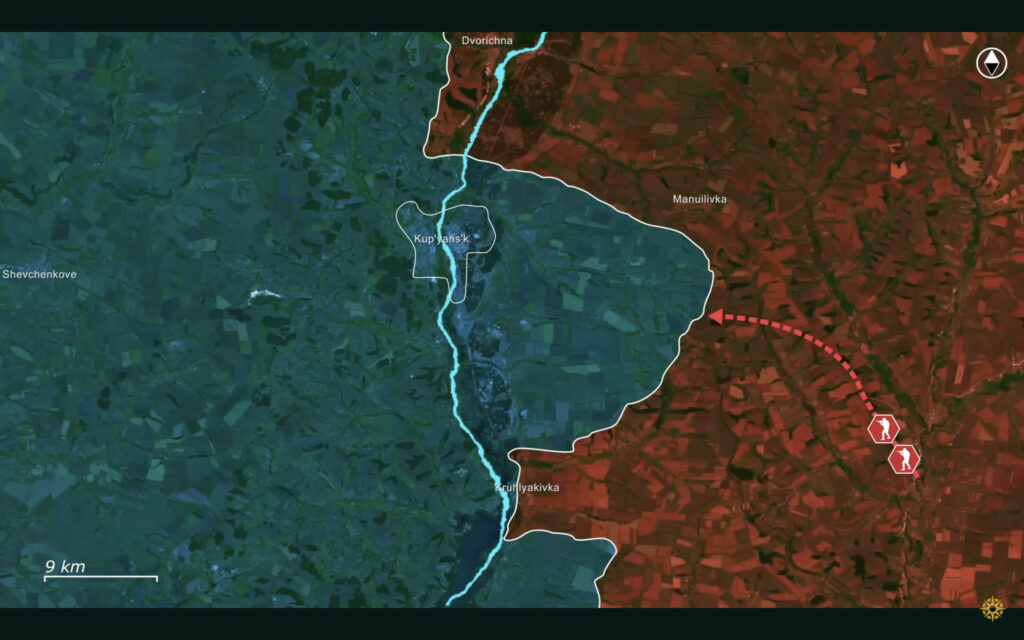Today, there are interesting updates from the Kupiansk direction, Kharkiv Oblast.
Here, the strategic Battle for Kupiansk is unfolding as Russian forces intensify efforts to cross the Oskil River and encircle the city, hoping to shift momentum in their favor. Yet, despite repeated assaults and tactical shifts, their advance remains stalled – trapped in a deadly fire pocket, crippled by logistics, and methodically dismantled by a patient and lethal Ukrainian defense.
The Battle for Kupiansk is characterized by persistent Russian pressure along two key axes. Primarily via the Pischane funnel, a narrow corridor extending westward toward the Oskil River. Here, Russian units attempt to widen their area of control, aiming to solidify positions near the riverbanks and save themselves from the deadly Ukrainian fire from 3 sides.
However, because of the fire pocket, Russian forces in this sector are severely undermanned, undersupplied, and critically lack armored support. Their presence largely consists of scattered infantry groups operating without meaningful logistical backing, rendering them particularly vulnerable to precise, small-scale raids by Ukrainian special forces.
Ukrainian forces, employing a robust active defense, maintain continuous pressure in an active defense, conducting raids with special forces teams to take prisoners, obtain mission-critical intelligence, and disrupt Russian force gathering efforts. Thus, Russian elements within the funnel remain strategically insignificant.
Given ongoing, high-stakes battles elsewhere, particularly around Toretsk, Pokrovsk, Kostiantynivka, and Sumy, allocating substantial Ukrainian resources to decisively eliminate this minor Russian penetration would be impractical. Additionally, pushing Russian forces back here would inadvertently shorten their overextended supply lines, unintentionally improving their logistical conditions. Therefore, Ukraine’s current strategy of containment and attrition effectively drains Russian manpower without compromising Ukrainian resources.

Meanwhile, Russian command persistently attempts to close the pocket around the Pischane funnel, striving to transform it into a platform for a more substantial advance directly toward Kupiansk and the strategically important Oskil River. Despite frequent offensive attempts, Russian progress remains negligible. Various tactics have been employed, including infantry-only assaults, motorcycle-mounted rushes, and even limited armor-supported pushes. Each of these efforts has consistently failed due to relentless and highly effective Ukrainian resistance.
Over several months, Russian forces have sought to widen the funnel’s eastern flank to alleviate the concentrated Ukrainian fire pocket. Despite their efforts, Russians have managed to widen only half the funnel, achieving little practical advantage. Consequently, this maintains the position that the Russian funnel itself presents no immediate strategic threat, as Russian forces continue to scatter valuable combat resources without achieving any real operational breakthrough toward Kupiansk.

Another critical element of Russian operations in the Kupiansk direction is their presence around the Dvorichna bridgehead. Here, Russian forces have managed to establish a precarious foothold across the Oskil River. However, their logistical situation is dire, relying exclusively on rubber boats traversing the river’s narrower stretches, which is an inherently unreliable method susceptible to Ukrainian interdiction. Despite being advertised as possessing amphibious capabilities, geolocated footage shows that Russian armored vehicles have repeatedly proven inadequate for effective river crossings.
Consequently, Russian offensive potential from this bridgehead is severely handicapped, relying almost entirely on infantry groups that gradually cross the river, and then mass together for concentrated assaults. This predictable approach frequently backfires: Ukrainian forces tactically permit certain Russian units to penetrate slightly, quickly sealing the breach afterward. Thus, isolated and encircled, these Russian groups are systematically neutralized, amplifying enemy losses.

Additionally, the recent Ukrainian air assault conducted deep behind Russian lines around the Dvorichna sector has substantially disrupted Russian rear-area logistics and command structures. This also deepened the operational difficulties Russian forces faced at the bridgehead, creating significant confusion and limiting their offensive effectiveness. Consequently, Russian advances in the Dvorichna area remain stalled, their positions static, and their capability for meaningful offensive action severely degraded.
Overall, the Ukrainian defensive strategy in the battle for Kupiansk remains highly effective, with Ukrainian commanders demonstrating exceptional operational patience by intelligently managing limited resources to contain and systematically treat Russian forces without excessive commitments. Ukrainian troops consistently exploit Russian weaknesses such as poor logistics, insufficient manpower, and ineffective tactics to inflict disproportionately high casualties, and instead of attempting costly counterattacks to eliminate strategically insignificant Russian penetrations, Ukrainian forces strategically capitalize on enemy mistakes while gradually eroding enemy combat potential.
This approach is methodically draining Russian powers along the Kupiansk front, ensuring that despite repeated efforts, the Russians have failed to secure any meaningful operational advantage or threaten key Ukrainian-held territory.
In our regular frontline report, we pair up with the military blogger Reporting from Ukraine to keep you informed about what is happening on the battlefield in the Russo-Ukrainian war.




